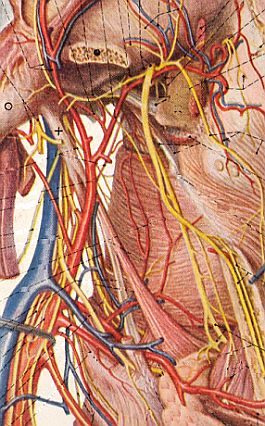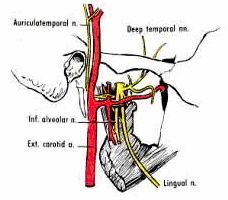 Nervi lingualis: el nervio maxilar inferior posee dos tronco terminales, anterior y posterior. El tronco terminal posterior se divide en cuatro ramas: el tronco común de los nervios del pterigoideo interno, del periestafilino externo y del músculo del martillo, el nervio aurículo-temporal, el nervio dentario inferior y el nervio lingual. Este último desciende por delante del nervio dentario y describe una curva cóncava hacia delante y hacia dentro. Discurre junto al dentario y en este nivel de su trayecto recibe la cuerda del tímpano. Una vez que rebasa el borde anterior del músculo pterigoideo interno, se dobla hacia delante y camina primero bajo la mucosa del surco gíngivo-lingual, por encima del borde superior de la glándula submaxilar y del ganglio submaxilar. Desciende enseguida por la cara interna de la glándula, contornea el conducto de Wharton de fuera a dentro, pasando por debajo de él y se sitúa por dentro de la glándula sublingual, entonces se divide en numerosas ramas terminales que inervan toda la mucosa de la lengua por delante de la V lingual. Uno de los ramos se hace descendente, anastomosándose con el hipogloso. En su trayecto da también algunos ramas para la mucosa del pilar anterior del velo del paladar, amígdalas, y ganglios submaxilar y sublingual que inervarán las glándulas correspondientes.
Nervi lingualis: el nervio maxilar inferior posee dos tronco terminales, anterior y posterior. El tronco terminal posterior se divide en cuatro ramas: el tronco común de los nervios del pterigoideo interno, del periestafilino externo y del músculo del martillo, el nervio aurículo-temporal, el nervio dentario inferior y el nervio lingual. Este último desciende por delante del nervio dentario y describe una curva cóncava hacia delante y hacia dentro. Discurre junto al dentario y en este nivel de su trayecto recibe la cuerda del tímpano. Una vez que rebasa el borde anterior del músculo pterigoideo interno, se dobla hacia delante y camina primero bajo la mucosa del surco gíngivo-lingual, por encima del borde superior de la glándula submaxilar y del ganglio submaxilar. Desciende enseguida por la cara interna de la glándula, contornea el conducto de Wharton de fuera a dentro, pasando por debajo de él y se sitúa por dentro de la glándula sublingual, entonces se divide en numerosas ramas terminales que inervan toda la mucosa de la lengua por delante de la V lingual. Uno de los ramos se hace descendente, anastomosándose con el hipogloso. En su trayecto da también algunos ramas para la mucosa del pilar anterior del velo del paladar, amígdalas, y ganglios submaxilar y sublingual que inervarán las glándulas correspondientes. <(F): Nerf lingual: rameau terminal du nerf mandibulaire; nerf sensitive majeur de la langue; situe dans la région submandibulaire et sublinguale; il naît dans la région ptérygomaxillaire, pénètre dans la région submandibulaire, suit le muscle stylo-glosse et entre sous la muqueuse su sillon alvéolo-lingual au niveau de la 3º molaire inférieure; il descend ensuite su la glande submandibulaire, conctourne et suit le conduit submandibulaire vers la région sublinguale; el reçoit du nerf intermédiare sa collatérale, la corde du tympan, qui sort du crâne par la fissure pétro-tympanique. Se place au borde supérieur de la glande submandibulaire sous la muqueuse du sillon alvéolo-lingual, descend sur sa face médiale puis croise son canal excréteur. Le ganglion submandibulaire est annexé au nerf lingual le long de son bord inférieur, il reçoit des filets parasymnpathiques du noyau salivaire supérieur par le nerf intermédiarie, la corde du tympan et le nerf lingual et il reçoit des filets sympathiques par le plexus sympathique de l´artère facial. El est vulnérable lors des extractions des dents de sagesse. El don de collatéral parfois pour les muscles ptérygoïdiens latéral et médial et le muscle palato-glosse. Terminations: el s´épanouit sous la muqueuse linguale.
 <(Ing): Lingual nerve: is a branch of the mandibular nerve (CN V3), itself a branch of the trigeminal nerve, which supplies sensory innervation to the tongue. It also caries fibres from the facial nerve, which taste information from the anterior two thirds of the tongue. Course and distribution: this is a branch of the posterior trunk of mandibular division of the trigeminal nerve. It is wholly sensory to the tongue, floor of mouth and upper jaw. It runs from its parent trunk between the tensor veli palatini and lateral pterygoid, where it is joined by the chorda tympani. It maintains a downward course, slightly forwards, towards the lower jaw, passing between the mandibular ramus and the medial pterygoid, and running in front of the inferior alveolar nerve. It then runs on the lateral side of the mandible to reach the root of third molar tooth where it can be palpated against the mandible. It passes on the side of the tongue, crossing the styloglossus to run on the lateral aspect of the hyoglossus, deep to the mylohyoid. It then divides into its terminal branches under cover of the mucosa of the tongue. It is joined by the chorda tympani, branches of inferior alveolar nerve and, hypoglossal nerve, by nerve loops, and submandibular ganglion. Branches: Secretomotor postganglionic parasympathetic fibers which relay in the submandibular ganglion and supply the lingual and sublingual glands; Gingival branches to the lower jaw; Mucosal branches to the tongue and floor of mouth. Root: sensory root is from the sensory nuclei extending from the spinal nucleus of trigeminal from the substantia gelatinosa of the upper cervical region to the medulla, and the pontine nucleus which lies in the floor of the 4th ventricle. This extends to the midbrain mesencephalic nucleus of V.
<(Ing): Lingual nerve: is a branch of the mandibular nerve (CN V3), itself a branch of the trigeminal nerve, which supplies sensory innervation to the tongue. It also caries fibres from the facial nerve, which taste information from the anterior two thirds of the tongue. Course and distribution: this is a branch of the posterior trunk of mandibular division of the trigeminal nerve. It is wholly sensory to the tongue, floor of mouth and upper jaw. It runs from its parent trunk between the tensor veli palatini and lateral pterygoid, where it is joined by the chorda tympani. It maintains a downward course, slightly forwards, towards the lower jaw, passing between the mandibular ramus and the medial pterygoid, and running in front of the inferior alveolar nerve. It then runs on the lateral side of the mandible to reach the root of third molar tooth where it can be palpated against the mandible. It passes on the side of the tongue, crossing the styloglossus to run on the lateral aspect of the hyoglossus, deep to the mylohyoid. It then divides into its terminal branches under cover of the mucosa of the tongue. It is joined by the chorda tympani, branches of inferior alveolar nerve and, hypoglossal nerve, by nerve loops, and submandibular ganglion. Branches: Secretomotor postganglionic parasympathetic fibers which relay in the submandibular ganglion and supply the lingual and sublingual glands; Gingival branches to the lower jaw; Mucosal branches to the tongue and floor of mouth. Root: sensory root is from the sensory nuclei extending from the spinal nucleus of trigeminal from the substantia gelatinosa of the upper cervical region to the medulla, and the pontine nucleus which lies in the floor of the 4th ventricle. This extends to the midbrain mesencephalic nucleus of V. ANATOMÍA:
- ANATOMY OF THE HUMAN BODY. <(Ing)
FUENTES DE INFORMACIÓN BIOMÉDICA:
- CISMeF. <(F)
- GOOGLE SCHOLAR. <(Ing)
- NCBI: Entrez. <(Ing)
- PubMed. <(Ing)
TÉRMINOS RELACIONADOS:
